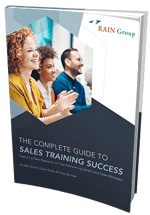How is the current state of the sales environment impacting sales organizations?
Which sales and enablement issues are most challenging for leaders to tackle?
What are the top sales priorities for the next 12 months? How should they be addressed to ensure they're achieved?
To find out the answers to these questions, we surveyed 322 sales, enablement, and company leaders globally, following up on our original research conducted in 2019.
The results provide insight into what’s changed, how the industry is evolving, and what sales and enablement professionals can do to adapt.
Top Challenges and Priorities of Sales and Enablement Leaders
- The Sales Environment
- Top Sales Enablement and Leader Challenges
- Sellers and Sales Leaders View Challenges Drastically Differently
- Value, Productivity, Account Growth, Pipeline, and Talent Among Top Priorities
- Why So Little Movement?
- How You Can Address the Top Sales Challenges and Priorities
- The Key to Success
The Sales Environment
To say a lot has changed in the sales environment since our last Top Sales Challenges and Priorities survey (2019) would be an understatement. As we’ve written elsewhere, changes are underway in the B2B selling environment.
The trends we’re seeing in the industry today are supported by the survey results, which include longer sales cycles and more opportunities being lost to no decision.
Sales Cycles Are Lengthening
Overall, in the past 12 months, the sales cycle time for deals has:
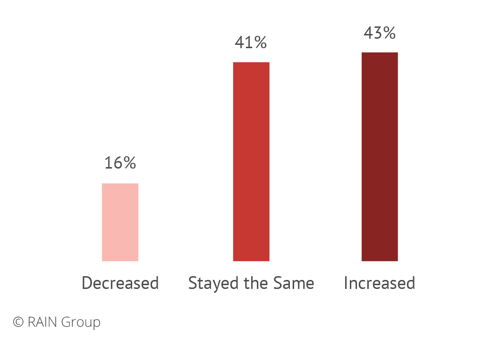
43% of sales leaders say sales cycle times have increased, only 16% say they've decreased.
Lost to “No Decision” Is on the Rise
Overall, how has the percentage of opportunities the sales force proposed or quoted on and lost to no decision changed?
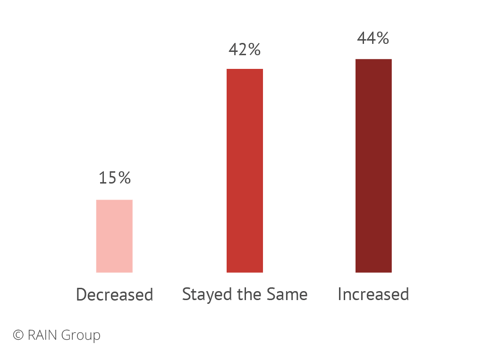
44% of sales leaders say the percentage of opportunities lost to no decision has increased, only 15% say it's decreased.
Competitor Losses Are on the Decline
Overall, how has the percentage of opportunities the sales force proposed or quoted on and lost to competitors changed?
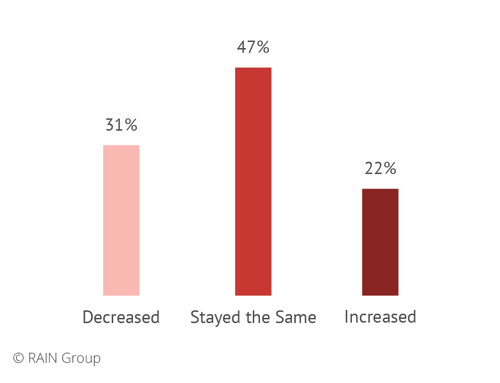
Only 22% of sales leaders say the percentage of opportunities lost to competitors has increased, 31% say it’s decreased.
As the saying goes: time kills sales. Many sales teams are experiencing this as the sales cycle extends and ends with buyers doing nothing at all.
Top Sales Enablement & Leader Challenges
We asked these same sales leaders about the top challenges they’re facing.
Top Challenges of Sales and Enablement Leaders
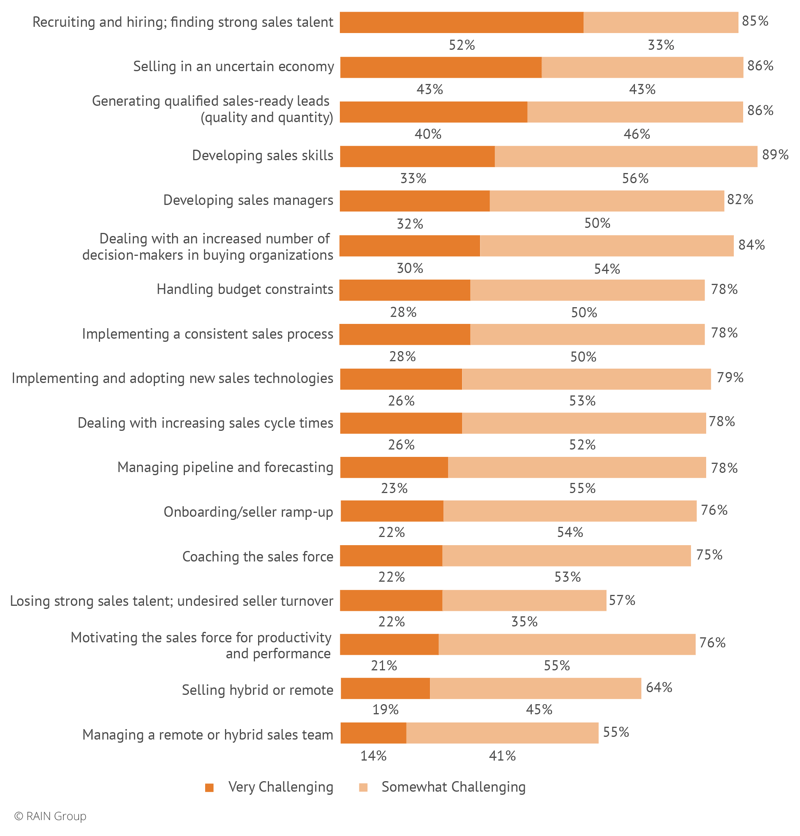
Except for selling in an uncertain economy (new in this survey), the top challenges remain the same as they did in 2019:
- Recruiting and hiring (finding strong sales talent): 52% of leaders find this very challenging
- Selling in an uncertain economy: 43% of leaders find this very challenging
- Generating qualified sales-ready leads (quality and quantity): 40% of leaders find this very challenging
- Developing sales skills (driving and winning sales opportunities, driving account growth, consultative selling, filling the pipeline, negotiation, managing and coaching sellers, etc.): 33% of sales leaders find this very challenging
- Developing sales managers: 32% of sales leaders find this very challenging
Interestingly, if you look to the bottom of the list, you’ll see virtual selling and managing virtual teams (both new questions in the 2023 survey) are ranked among the least challenging. It appears many sales leaders believe they’re on track in terms of adapting to the changing work and selling environment and adopting a hybrid approach. These issues are less acute than the other challenges they’re facing, but more than half are at least somewhat challenged here.
Overall, we were surprised that most of the challenges remained the same. Take recruiting and hiring top sales talent, the top challenge in 2019 and today. It’s true, it’s hard to:
- Attract top talent
- Identify which candidates are the "real deal"
- Convince the right candidate to accept your offer
- Onboard talent so they get to full sales productivity quickly
- Retain top talent
In fact, recent research from LinkedIn shares that, “Three of the top five factors that people consider when pursuing new jobs reflect their desire to stretch, grow, and develop new skills.”
Given this, it’s easy to see how the challenges work together and compound each other. Two of the top five challenges revolve around developing skills. Developing these skills takes time and ongoing effort (think everboarding) and this is just as challenging today as it was in 2019.
However, the sales organizations that do this—and do it well—can attract better talent and retain the top talent they already have (see more on this in our recommendations below).
Sellers and Sales Leaders View Challenges Drastically Differently
We went on to ask both sellers and sales leaders to consider the issues facing sellers in their organization. For each item we had them indicate how challenging it is for sellers.
By and large, sellers and leaders don't see challenges the same way.
How challenging are the following issues to sellers in your organization?
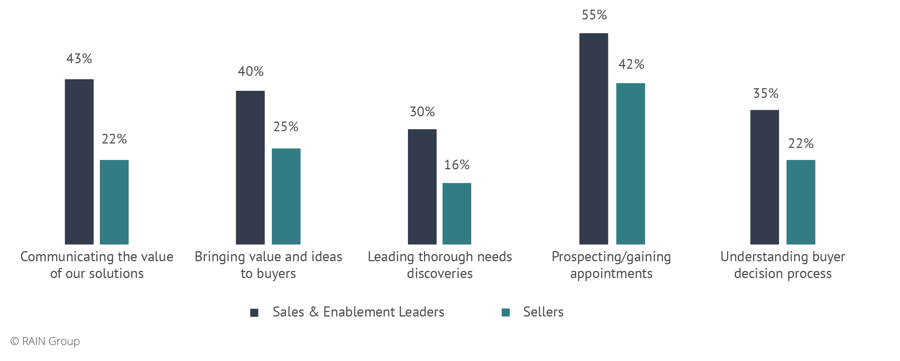
The largest differences come in the areas of:
- Communicating the value of solutions
- Bringing value and ideas to buyers
- Leading thorough needs discoveries
- Prospecting/gaining appointments
- Understanding the buyer decision process
Except for prospecting, sales leaders report each of these as much more challenging than sellers report them. Indeed, sellers tend to have higher opinions of their skills. And when it comes to prospecting, both leaders and sellers rate this as very challenging.
Take "leading a thorough needs discovery" as an example. Only 16% of sellers report this as challenging. We know from previous buyer-side research that leading an effective needs discovery is highly influential to buyers' purchasing decisions.
You may see this and think, “Great! Sellers are good at this and it’s important.” But not so fast. In that same study, we also asked buyers about their buying experience and how well sellers performed at this particular skill. Only 26% of buyers believe sellers are skilled at leading a thorough needs discovery.
This demonstrates the great disconnect between what sellers think, what leaders think, and what buyers experience.
Value, Productivity, Account Growth, Pipeline, & Talent Among Top Priorities
Not surprisingly, the top sales priorities are largely geared toward tackling the top challenges. Of 22 potential priorities, the following 10 rose to the top as very important:
Top Priorities of Sales and Enablement Leaders
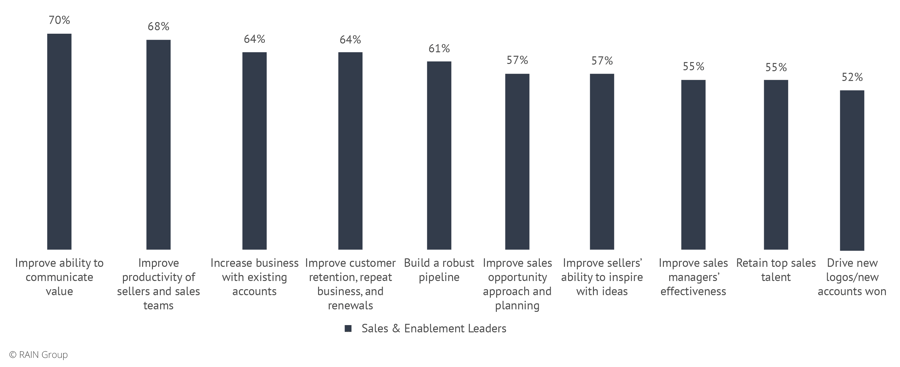
- Improve ability to communicate value: 70%
- Improve productivity of sellers and sales teams: 68%
- Increase business with existing accounts: 64%
- Improve customer retention, repeat business, and renewals: 64%
- Build a robust pipeline: 61%
- Improve sales opportunity approach and planning: 57%
- Improve sellers' ability to inspire with ideas: 57%
- Improve sales manager effectiveness: 55%
- Retain top sales talent: 55%
- Drive "new logos"/new accounts won: 52%
Overall, the top priorities remain similar to our 2019 study, with the addition of two new items: building a robust pipeline and retaining top sales talent.
When you look at the challenges (sales enablement/leader challenges and seller challenges) along with the priorities, a few themes begin to appear:
Value
Driving value, communicating value, offering valuable insights and ideas, convincing buyers of your value—all of these come forth in this and other research. This is why value is at the center of our Top-Performer Seller model (see below) and why the importance of sellers driving value has never been more important.
Buyers used to expect sellers to explain their product or service or develop a solution that matches their problem. Now they expect sellers to give strategic advice and drive value over-and-above their product in every touch.
Productivity
As sales leaders continue to navigate economic uncertainty, facing longer sales cycles, reduced demand, budget cuts, layoffs, and high turnover rates, the directive becomes "do more with less."
We know from other research that 71% of companies don't believe their sellers manage their time and day effectively. On the other hand, Top-Performing Sellers are much more likely to:
- Focus on their own agenda
- Maximize time spent on activities that drive the best result
- Get the most done and produced in the time available
Equipping your team with the habits needed to optimize their time, stay focused on their priorities, and increase motivation is the best way to drive results in challenging times.
Growing Accounts
Driving account growth and customer retention continues to be a top priority among sales leaders. Success here can directly help the current #2 challenge: selling in an uncertain economy.
It’s important that organizations not only retain their existing customers but work to grow their accounts. We’re seeing an increased focus on alignment between customer success and sales teams to drive this growth.
Pipeline Generation
Prospecting used to be difficult (and it still is), but it was easier to understand. Buy a directory, send direct mail, call, call again, get an appointment, and take it from there.
Now it’s a complex mix of outreach media, technologies, long-term touch sequences, value-based offers, alignment with marketing, email laws and rules, and more. Buyers also have access to a never-ending amount of information at their fingertips, so the bar is higher on which meetings are accepted.
Talent
Earlier, we noted the challenge of hiring and retaining top talent. Interestingly, this factor is now among the top 10 priorities. An area that cannot be overlooked here is the sales manager’s role in motivating and developing talent. The adage is true: people don’t leave companies, they leave managers. I expand upon this in our recommendations below.
Why So Little Movement?
You could say these challenges and priorities are perennial. That is, they’re indicative of core levers to move the needle on sales results. You could also say that despite best efforts, it’s increasingly difficult to do.
A few reasons why sales organizations may not be seeing the movement they’d like here include:
- Recruiting strong sales talent is tough, even in the best of times, and relying on hiring top performers tends not to work.
- Improving sales competencies requires an ongoing effort and takes time to generate results.
- Sellers and leaders often don’t see selling challenges the same way. For example, while 43% of leaders say communicating value is very challenging for sellers, only 22% of sellers say it is. This disconnect can lead to sellers and sales and enablement professionals being at odds, or at least not seeing the value of certain approaches.
- And, finally, sales training programs and other support initiatives undertaken with good intentions often fail to deliver the promised results.
How You Can Address the Top Sales Challenges and Priorities
We've identified three sales enablement strategies you can focus on to achieve nearly all the top priorities and tackle the top sales challenges.
For those who execute these initiatives well, you'll make the #1 challenge—recruiting top sales talent—much less important because you'll be developing your own top talent.
The top three recommendations for overcoming sales challenges and achieving priorities are:
1. Improve Sales Productivity
Most productivity initiatives center around technology or process. When companies focus on the areas we outline, they achieve significantly stronger results than just focusing on tech or process.
Most organizations could increase their sales productivity by 46% without needing to hire anyone at all.
Sounds like marketing puffery, right?
Not necessarily.
For The Extreme Productivity Benchmark Report, we studied 2,377 sellers and non-sellers to uncover the behaviors of productive people.
Interestingly, we found that 47% of people waste a great deal of time at work (not a little, not a moderate amount—a great deal of time). That’s nearly half of your sales force wasting a significant amount of time each day.
Most people report spending an average of 4.3 hours per workday on non-value-add activities.
On the flip side, we also asked how many hours per day people spend on their Investment activities (i.e., high-return, value-add activities). Those who rate themselves as Extremely Productive (The XP) spend a great deal more time on their priorities than The Rest.
The XP spend an average of 5.7 hours per day on Investment activities compared to just 3.9 hours spent by The Rest.
Hours Spent Per Work Day on Value-Add (Investment) TIME
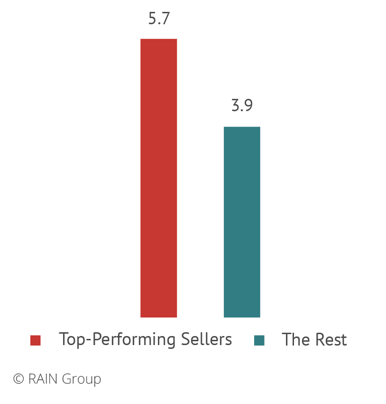
That’s 46%(!) more time on Investment activities each week.
In other words, the potential is there to increase sales force productivity by 46% without hiring any new sellers. How? Make it a priority to improve seller productivity.
The impact here can’t be overstated. Think about it: people from the same companies, with the same technologies and administrative environments, and the same sales managers are getting a lot more out of their time than their peers based on their personal work habits.
Few areas drive sales performance more than the productivity of the sales team.
Note that most sales productivity tools can help a little, but it isn’t tools we’re talking about—it’s work habits. How sellers tackle their jobs and tackle their days is what makes for productivity success and failure.
The great news is productivity can, in fact, be learned.
The bad news is too many initiatives focus on some kind of productivity technology, which more often than not turns out to be the parsley on the plate of the steak dinner. It’s a part of the dinner, but the meat is something else altogether.
Extremely Productive sellers employ a set of habits and behaviors that drive not only their productivity, but also their performance, happiness, and job satisfaction.
Read more about these productivity habits. >>
Think about your sales force as it is today. If it’s like the respondents in The Extreme Productivity Benchmark Report, 14% of them are already Extremely Productive. They likely employ these habits and the 36 hacks and behaviors that underpin them. This group is also significantly more likely to be top performers, satisfied with their jobs, and very happy.
The remaining 86%? Not so much.
While it’s understandable the top challenge is recruiting and hiring strong sales talent, the opportunity available to all of us is to enable our teams to be Extremely Productive and give them the skills they need to succeed. Achieve this and you’ll have the net effect of adding more sales staff for lower cost.
2. Develop Multi-Skilled Sellers
Sales skill training is already a priority for many organizations, but flavor of the month training is still rampant, long-term adoption of a consistent selling method is rare, and measurable results are elusive. We propose new thinking—from the vendor side (us) and the buyer side—to change this.
Each of the top sales priorities noted above has to do with developing sales skills and it’s worth noting that more than 50% of sales leaders rate each as “very important.”
The good news…
Top-Performing Sales Organizations have this figured out and they work to develop skills across all these topics systematically.
The path to success in getting there is in the vision, approach, and change management mindset you take to your sales training initiatives.
An early step in the process is to build a sales competency model to understand the skills your sellers need. If you have defined the skills, knowledge, and attributes, you can define the content and format of training best suited to build them.
We use our Top-Performing SellerSM model, which is research-validated. It identifies the capabilities and behaviors that separate Top-Performing Sellers from other sellers.
The Top-Performing SellerSM
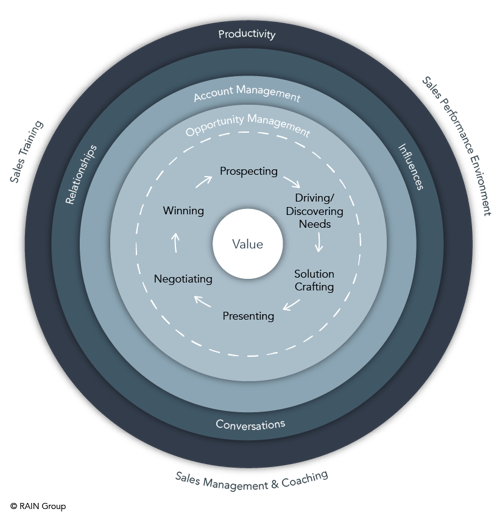
Our research shows that Top Performers are statistically significantly more capable in the following categories of selling:
-
Value: Value is at the center and aligns with the top priority of leaders to improve seller ability to communicate value. This has never been more important as we face an uncertain economy and increasing sales cycle times. We always start with value.
-
Selling across the sales cycle: From prospecting to uncovering needs to winning, Top-Performing Sellers have success across the sales cycle and manage opportunities well. Importantly, it’s not one capability that distinguishes the best sellers.
This is where many sales enablement and leaders get it wrong. They focus on developing one skill, when it’s the breadth and depth of skills that lead to top performance.
Click here to download the Selling Across the Sales Cycle PDF. >>
-
Growing Accounts: Top Performers are more proactive and skilled at driving account growth.
-
Succeeding with people: Top Performers are more effective with people. Our research supports they're better at developing relationships, leading sales conversations, and influencing buyers.
-
Productivity: As discussed above, there’s a strong correlation between a seller’s productivity behaviors and habits and their likelihood to become top performers.
Outside the circle are three major external influences on sales performance which sellers do not control: sales management and coaching, sales training, and sales performance environment. Each must be in place to drive success systematically across your sales organization.
As you can see, value, prospecting, growing accounts, and productivity are all top priorities noted above and all are encapsulated in this model.
Once you have a competency model in place (using ours or your own), you must then attend to:
- Sales Curriculum: How will you foster a culture of continuous learning across the team? How will skills build upon each other? How will sellers continue to up their game and improve? Think everboarding here.
- Embedding Plan: How will you embed a consistent sales method in the culture that everyone learns, creating a common language in your sales organization?
- Modern Training: How will training be delivered in a way that reaches sellers where they are? What technologies will you utilize? How will training be reinforced? What are the participation expectations?
- Sales Manager Capability: How will you enable sales managers to make sure skills are adopted and applied consistently so they become habits across the sales team (see next point)?
- Sales Enablement Team Support: What support does the enablement team need to train teams on a method—technology, training programs, models, intellectual property (IP), train-the-trainer (TTT), etc.?
There’s much more underlying these broad categories, such as defining a change management and implementation plan and measuring and reporting results. Read the Complete Guide to Sales Training Success for more detail here.
Big picture: if you succeed with the points outlined above, you’ll be well on your way to success.
3. Leverage Sales Managers
Sales managers are a key leverage point for most sales organizations. Managers are the ones working with sellers one-on-one, keeping them focused, advising them, checking in, and helping them stay motivated for the long term.
A great sales manager is often the difference between an average and a top-performing team. They’re also often the difference between seller retention and turnover.
It’s understandable why sales manager development is in the top five most frequent challenges reported by sales and enablement leaders, with nearly one-third of leaders citing this as very challenging and 55% reporting it as a very important priority.
Our other research on sellers and sales managers shows that sellers are 63% more likely to become Top Performers when they report having an effective sales manager, regular coaching, and effective sales training.
Impact of Effective Manager + Regular Coaching + Effective Training on Seller Performance
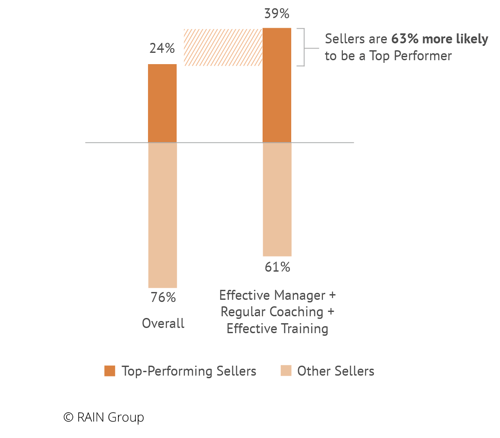
Sales managers have a lot they need to do:
- Recruiting, hiring, and onboarding
- Reporting and forecasting
- Territory planning
- Managing up
- Sales coaching
- Planning and leading team meetings
The first three areas can suck up inordinate amounts of time, yet it’s the last area that’s key: sales managers can unlock sales performance through coaching.
However, most sales managers come up through the sales ranks and achieve the title of sales manager because of their exemplary individual selling performance. They don’t necessarily know how to manage and coach sellers. They assume that what worked for them will work for others.
This is often not the case.
For sales managers to succeed, they must excel at the following 5 Roles of a Sales Coach:
-
Motivate: The #1 sales management and coaching skill difference between Top-Performing Sales Managers and other managers is motivating sellers for high productivity and performance. Top-Performing Sellers are 71% more likely to have a manager that excels here.
Sales managers must motivate sellers and help them find and sustain their highest level of energy and action each day and over the long term.
-
Focus: Let’s assume for a minute we reviewed how your sellers spent a week’s worth of their time. Think they’d be doing the right activities, from morning until when they knock off for the day, across the board?
Not likely.
The best sales managers help sellers focus their energy and efforts on the activities that yield the best return on their time. Once those activities are identified, they help sellers maintain focus while avoiding the distractions that derail so many every day.
Top-Performing Sales Managers are 41% more likely to excel at helping sellers build meaningful goal and action plans. This keeps sellers focused on the right activities so their weekly actions are aligned and build towards achieving their goals.
-
Execute: Sales managers must help sellers execute in the zone, the place where sole focus on one activity yields a feeling of energized focus, involvement, and enjoyment of the activity. Top-Performing Sellers are significantly more likely to be highly rated across all major productivity areas. If sellers execute in the zone on the right activities, your sales force will produce amazing results.
-
Advise: In some schools of coaching thought, coaches should avoid giving direct advice because it hinders sellers’ progress. A good sales manager knows when to do this (i.e., teach a man to fish) and also when to give them ideas directly to win a sale. In any case, great sales managers are constantly running deal reviews (which we call Win Labs). Top-Performing Sales Managers are more likely to excel at coaching sellers to lead great sales conversations (52%), win sales opportunities (45%), grow accounts (47%), and fill the pipeline (30%).
Great sales managers do this. Most sales managers don’t do this nearly enough.
- Develop: The best sales managers develop sellers’ knowledge, skills, and attributes to improve performance. They reinforce new skills and hold sellers accountable for applying the knowledge.
Without sales manager support and great coaching, any efforts to implement the first two recommendations—improve sales productivity and develop multi-skilled sellers—will fail. Top-Performing Sales Managers are 37% more likely to excel at coaching sellers to build sales skills. This is also the #1 key driver of sales manager effectiveness.
Sales managers can play a key role in overcoming common challenges and achieving priorities. How you leverage managers and the attention paid here is vitally important.
The Key to Success
It’s easy to read the three recommendations above and nod your head in agreement. After all, they tackle the top challenges and priorities of sales leaders.
But it’s not easy to make them come alive.
How do you get it all done?
As a sales leader, you need to:
- Build a sales team with deep, diverse skills
- Develop managers to unleash seller potential
- Improve the productivity of your sales force
- Generate qualified, sales-ready leads
- Ramp up sellers and teams faster
- Make lasting change in seller behavior and skills
And you need to do all this for the least amount possible while showing impressive results.
Many turn to sales training.
As a sales training company, you might think we’re thrilled to see and hear this.
Yes and no.
Too many organizations approach training with a short-term perspective. They focus on a program to develop a specific skill. They see short-term improvements in results and ROI and call it a success.
It can be difficult, however, to get budget every year for every new skill, every new initiative, and every new workshop. While sales enablement and leaders have the best intention of keeping a new skill initiative alive and embedding it in the culture, structural problems can get in the way.
Over time, sellers who were trained in the specific skill leave. New hires aren't trained in the skill. The skill isn't reinforced beyond 3-6 months, so people go back to their old habits. And rarely do sales leaders plan in advance for the next logical skill to build upon the first.
When this happens, whatever your competency model looks like, it doesn’t come alive.
Still, it’s what you need to do, and the team at RAIN Group is committed to changing what we do to help you make this happen.
Developing a multi-skilled, highly productive sales force with great sales managers is key to success. As an industry, we must do a better job of helping our clients move beyond the “one skill at a time” approach.
Through RAIN Group Total Access, it’s our intention to change how sales leaders approach seller and sales manager development, how they buy sales training, and how they embed a sales method in their organization.
Total Access gives you the flexibility and customization necessary to grow sales skills your way, on your time. Access our fully-developed content library and deploy training virtually, in-person, or both. You'll also get resources to support implementation and ongoing coaching.
You can overcome the sales and enablement challenges you’re facing and achieve your priorities, and we can help. Reach out today to learn how we can support your initiatives and help you overcome your top challenges and achieve your priorities.






